Blank L., Tarquin A. Engineering Economy (McGraw-Hill Series in Industrial Engineering and Management)
Подождите немного. Документ загружается.

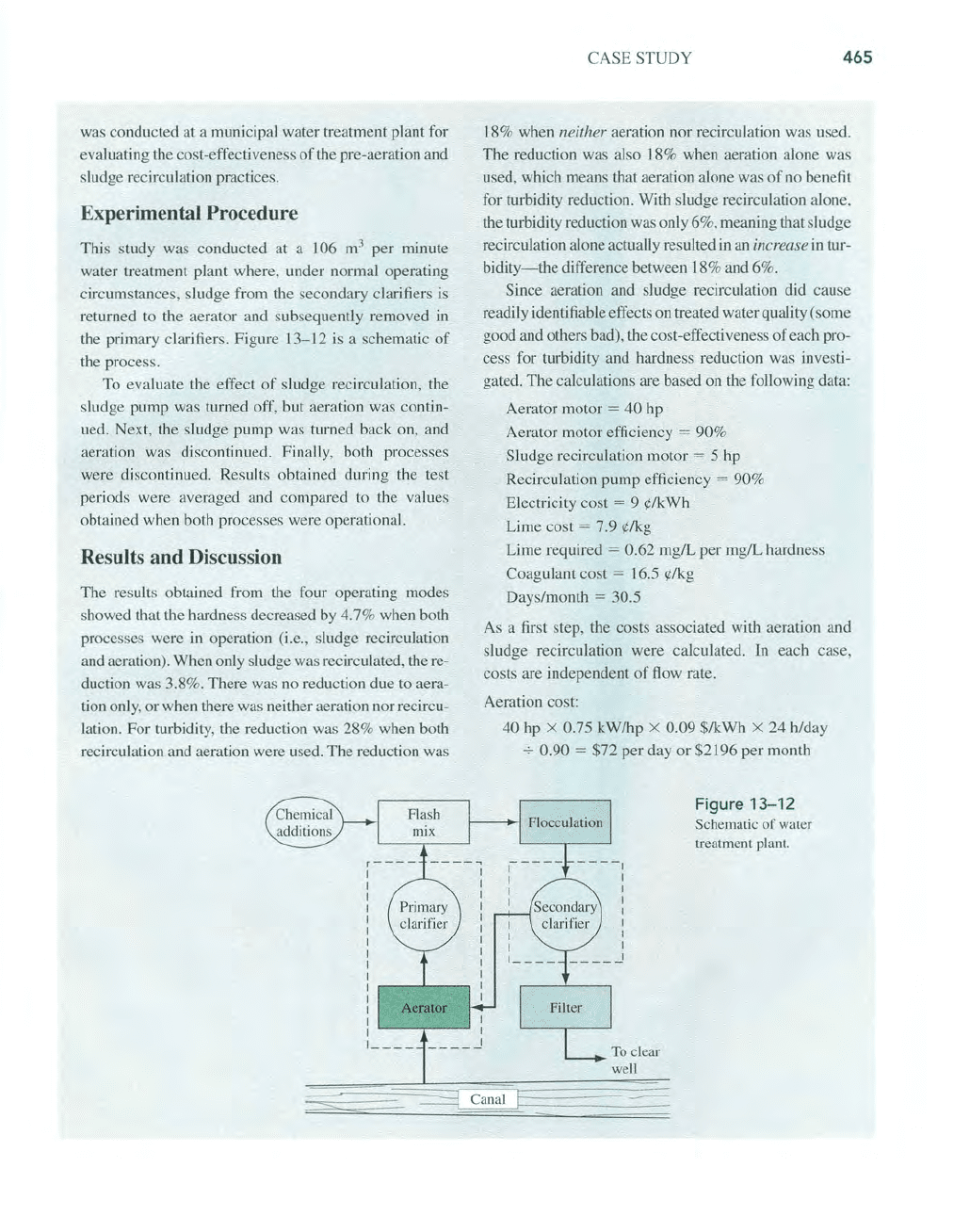
was conducted at a municipal water treatment plant for
evaluating the cost-effectiveness
of
the pre-aeration and
sludge recirculation practices.
Experimental Procedure
This study was conducted at a
106
m
3
per minute
water treatment plant where, under normal operating
circumstances, sludge from the secondary clarifiers is
returned
to
the aerator and subsequently removed
in
the primary clarifiers. Figure 13-12 is a schematic
of
the process.
To evaluate the effect
of
sludge recirculation, the
sludge pump was turned off, but aeration was contin-
ued. Next, the sludge pump was turned back on, and
aeration was discontinued. Finally, both processes
were discontinued. Results obtained during the test
peri.ods were averaged and compared to the values
obtained when both processes were operational.
Results and Discussion
The results obtained from the four operating modes
showed that the hardness decreased by 4.7% when both
processes were in operation (i.e., sludge recirculation
and aeration). When only sludge was recirculated, the re-
duction was 3.8%. There was
no
reduction due to aera-
tion only, or when there was neither aeration nor recircu-
lation. For turbidity, the reduction was 28% when both
recirculation and aerati
on
were used.
The
reduction was
1
1
1
1
1
1
1
1
1
1
1
r-
-
.,...L-
_~
1
1
1 1
1 1
L
_______
...I
CASE STUDY
465
18% when neither aeration nor recirculation was used.
The
reduction was also 18% when aeration alone was
used, which means that aeration alone was
of
no
benefit
for turbidity reduction. With sludge recirculation alone,
the turbidity reduction was only 6%, meaning that sludge
recirculation alone actually resulted
in
an
increase
in
tur-
bidity-the
difference between
18
% and 6%.
Since aeration and sludge recirculation did cause
readily identifiable effects on treated water quality (some
good and others bad), the cost-effectiveness
of
each pro-
cess for turbidity and hardness reduction was investi-
gated. The calculations are based on the following data:
Aerator motor
=
40
hp
Aerator motor efficiency
= 90%
Sludge recirculation motor = 5 hp
Recirculation pump efficiency
= 90%
Electricity cost = 9 ¢/kWh
Lime cost
= 7.9 ¢/kg
Lime required
= 0.62 mg/L
per
mg/L hardness
Coagulant cost
= 16.5 ¢/kg
Days/month
= 30.5
As a first step, the costs associated with aeration and
sludge recirculation were calculated.
In
each case,
costs are independent
of
flow rate.
Aeration cost:
40 hp X 0.75 kW/hp X 0.09 $/kWh X 24 h/day
7 0.90 = $72 per day
or
$2196 per month
1
1
1
1
1
1
1
1 1
1
________
...I
To clear
well
Figure
13-12
Schematic
of
water
treatment plant.
~
Canal F
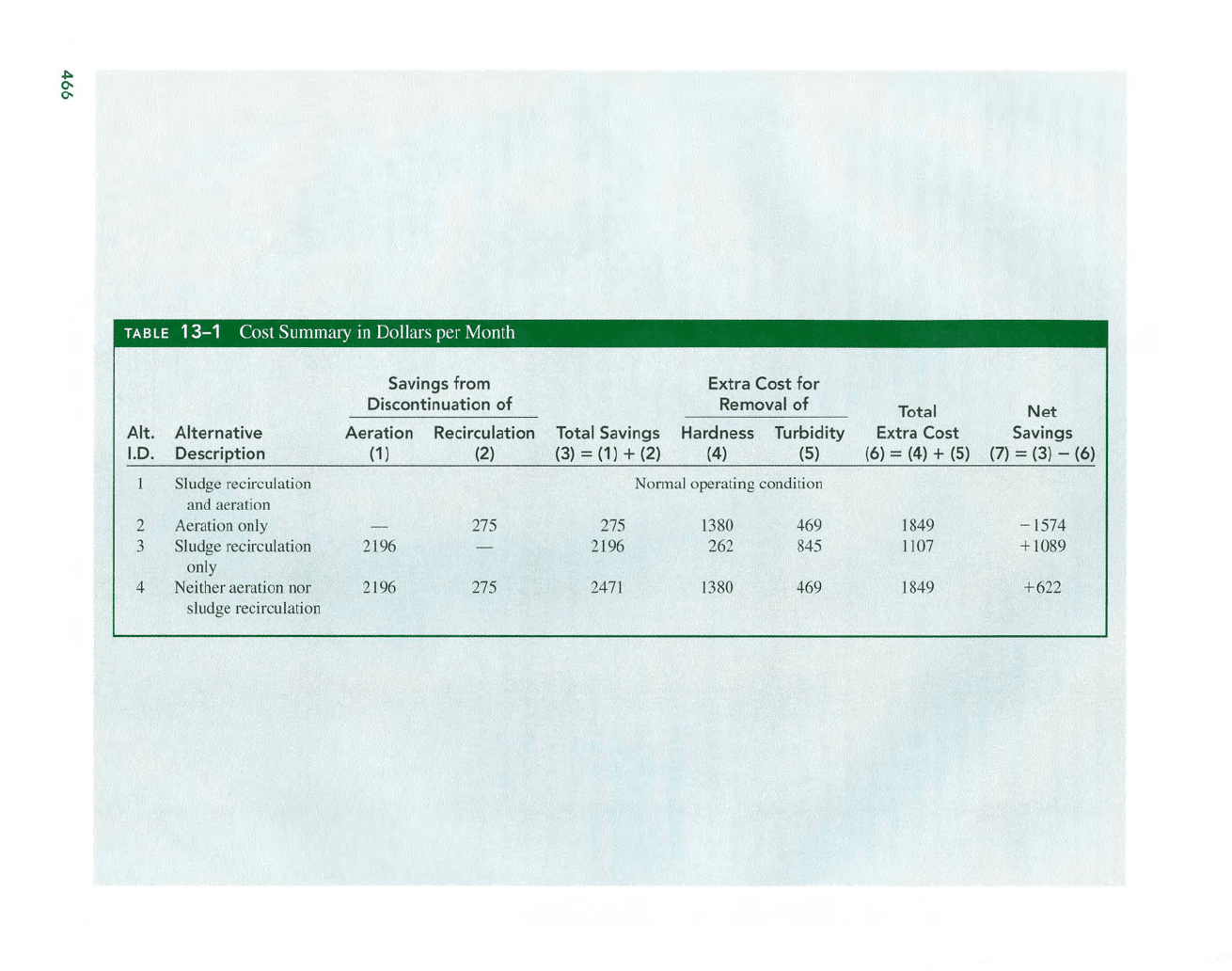
~
0-
0-
Alt.
1.0.
2
3
4
Alternative
Description
Sludge recirculation
a
nd
aeration
Aeration o
nl
y
Sludge recirculation
o
nl
y
Neither aeration nor
sludge recirculation
Savings from
Discontinuation
of
Aeration Recirculation
(1
) (2)
27
5
21
96
21
96
2
75
Extra Cost
for
Removal
of
Total
Net
Total Savings Hardness Turbidity Extra Cost Savings
(3)
= (1) + (2)
(4) (5)
(6) = (4) + (5)
(7)
= (3) - (6)
Normal opera
ti
ng condition
27
5 1
38
0
4
69
1849 -
1574
21
96
262
845
11
07
+
1089
24
71
13
80
469
1
849
+6
22
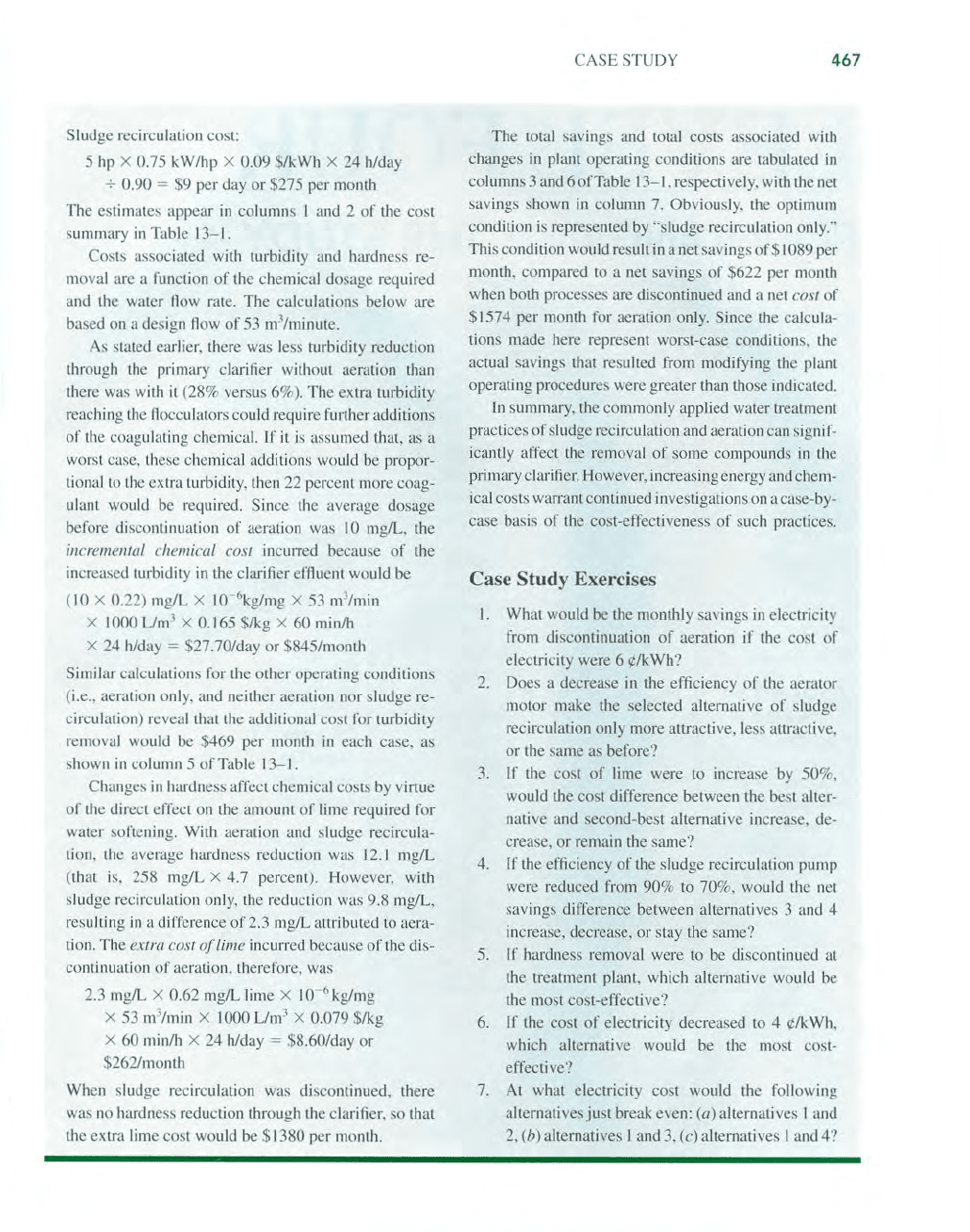
S
lu
dge recirc
ul
a
ti
on
cos
t:
5 hp X
0.75
kW/
hp X 0.
09
$/kWh X
24
h/d
ay
-;-
0.90 = $9 per day or $275 per month
The
es
timates app
ea
r
in
columns I and 2 of
th
e cost
summary
in
Table 1
3-
1.
Costs associated with turbidity and hardness re-
m
ova
l are a f
un
c
ti
on
of
the che
mi
cal dosage required
and the wat
er
fl
ow rate.
Th
e
ca
lc
ul
a
ti
ons bel
ow
are
based on a design
fl
ow
of
53 m
3
/minute.
As stated ea
rli
er,
th
ere was less turbidity reduc
ti
on
th
rough
th
e primary cla
ri
fie
r without
ae
ra
ti
on than
th
ere was w
it
h
it
(28%
ve
rsus 6%
).
The extra turbidity
re
aching the
f1
occ
ul
ators could require further additions
of
th
e coag
ul
ating che
mi
cal.
If
it
is assumed that, as a
worst case, these chemical additions would be propor-
t
io
nalt
o
th
e extra turbidity,
th
en 22 per
ce
nt more
co
ag-
ul
ant would be required. Since
th
e average dosage
before
di
scontinua
ti
on
of
aera
ti
on was
10
m
g/
L, the
in
cremen
ta
l chemical cost
in
curred because of
th
e
in
creased turbidity in
th
e clarifi
er
e
fflu
ent would be
(lO X 0.22) mg/L X
1O
-
6
kglmg X 53 m
3
hn
in
X 1
000
Lim
3
X 0. 165 $/kg X
60
min/h
X 24 h/day
=
$27.
70/d
ay
or
$845/
month
S
im
ilar calc
ul
ations
fo
r the other operat
in
g conditions
(i.e.,
ae
ra
ti
on o
nl
y,
and neither aera
ti
on nor slud
ge
re-
circ
ul
a
ti
on) reveal that
th
e additional cost for turbidity
removal wo
ul
d be $469 per month
in
each case, as
shown
in
column 5
of
Ta
bl
e 1
3-1.
Changes
in
hardness affect che
mi
cal costs by virtue
of
the dir
ec
t effect on
th
e amount of lime required for
water so
ft
enin
g.
With aeration and sludge recirc
ul
a-
ti
on,
th
e average hardness reduc
ti
on was 12
.1
mg
/L
(
th
at i
s,
258 mg/L X 4.7 percent
).
However, with
slud
ge
recirculation only,
th
e reduc
ti
on was 9.8 mg/L ,
resulting
in
a difference of 2.3 mg/L attributed to a
era
-
ti
on. The extra cost a
flim
e
in
curred b
eca
use of
th
e dis-
co
ntinua
ti
on of
ae
ration, therefore, was
2.3 mg/L X 0.62 mg/L lime X
1O
-
6
k
g/
mg
X 53 m
3
/min X 1000 Lim
3
X 0.079 $
/k
g
X 60 m
in
/h X
24
h/day = $8.60/d
ay
or
$262/month
When s
lu
dge recirc
ul
a
ti
on was discontinued,
th
ere
was no hardness reduc
ti
on through
th
e cla
ri
fie
I'
, so tbat
the extra lime cost would be
$ 1380 per month.
CASE
STUDY
467
The total savings and t
ota
l costs associated with
changes
in
pl
ant operating conditions are tab
ul
ated in
columns 3 a
nd
6
of
Ta
bl
e 1
3-
1, resp
ec
tivel
y,
with
th
e net
sav
in
gs shown
in
column 7. Obviousl
y,
the optimum
condition is represented by
"s
ludge recirc
ul
a
ti
on o
nl
y."
This condition would result
in
a net sav
in
gs
of$
1 089 per
month,
compa
red to a net sav
in
gs
of
$622 per month
when b
ot
h processes are
di
scontinued and a net cost
of
$
15
74
per month for
ae
ra
ti
on only. Sin
ce
th
e calc
ul
a-
ti
ons made here repr
ese
nt w
or
st-case condition
s,
the
actual savings that resulted from modify
in
g
th
e
pl
ant
operating procedures were greater than those
in
di
ca
ted.
fn
summa
ry
, the
co
mmonly applied wat
er
tr
ea
tm
ent
prac
ti
ces
of
sludge recirc
ul
ation and
ae
ration can sig
ni
f-
icantly
aFf
ec
t
th
e removal
of
some compounds
in
th
e
pri mary cla
ri
f
ie
r.
However, increasing energy a
nd
chem-
ical costs warra
nt
continued investigations on a case-by-
case basis of
th
e cost-effectiveness of such prac
ti
ces.
Case Study Exercises
I. What would be the monthly sav
in
gs
in
electricity
from discontinua
ti
on of aeration if
th
e cost
of
electricity were 6 ¢/kWh?
2. Does a d
ec
r
ease
in
the e
ffi
ciency of
th
e
ae
rator
motor make the sel
ec
ted
al
te
rn
a
ti
ve
of
slud
ge
recircula
ti
on o
nl
y more attr
ac
ti
ve, less attractive,
or the same as b
efo
re?
3.
If the cost of lime were to increase by
50
%,
would
th
e cost
di
fferen
ce
between the best alter-
na
ti
ve and second-best alterna
ti
ve
in
crease, de-
crease, or rema
in
the sam
e?
4. ff
th
e e
ffi
ciency
of
th
e slud
ge
recirc
ul
a
ti
on pump
were reduced
fr
om
90
% to
70
%, would
th
e net
savings
dif
fe
rence between alternatives 3 and 4
increase, decrease,
or
stay the
same
?
5. If hardness removal were to be
di
scontinued at
the treatment
pl
ant, which alterna
ti
ve would be
the most cost
-e
f
fec
ti
ve?
6. If the cost of el
ec
tricity d
ec
r
ease
d to 4 ¢/kWh,
w
hi
ch a
lt
erna
ti
ve
wo
uld be the most cost-
ef
fec
ti
ve?
7. At what electricity cost
wo
ul
d the fo
ll
ow
in
g
alte
rn
a
ti
ves
ju
st break eve
n:
(a) alte
rn
a
ti
ves I and
2, (b) a
lt
e
rn
atives I and 3, (c) alternatives I a
nd
4?
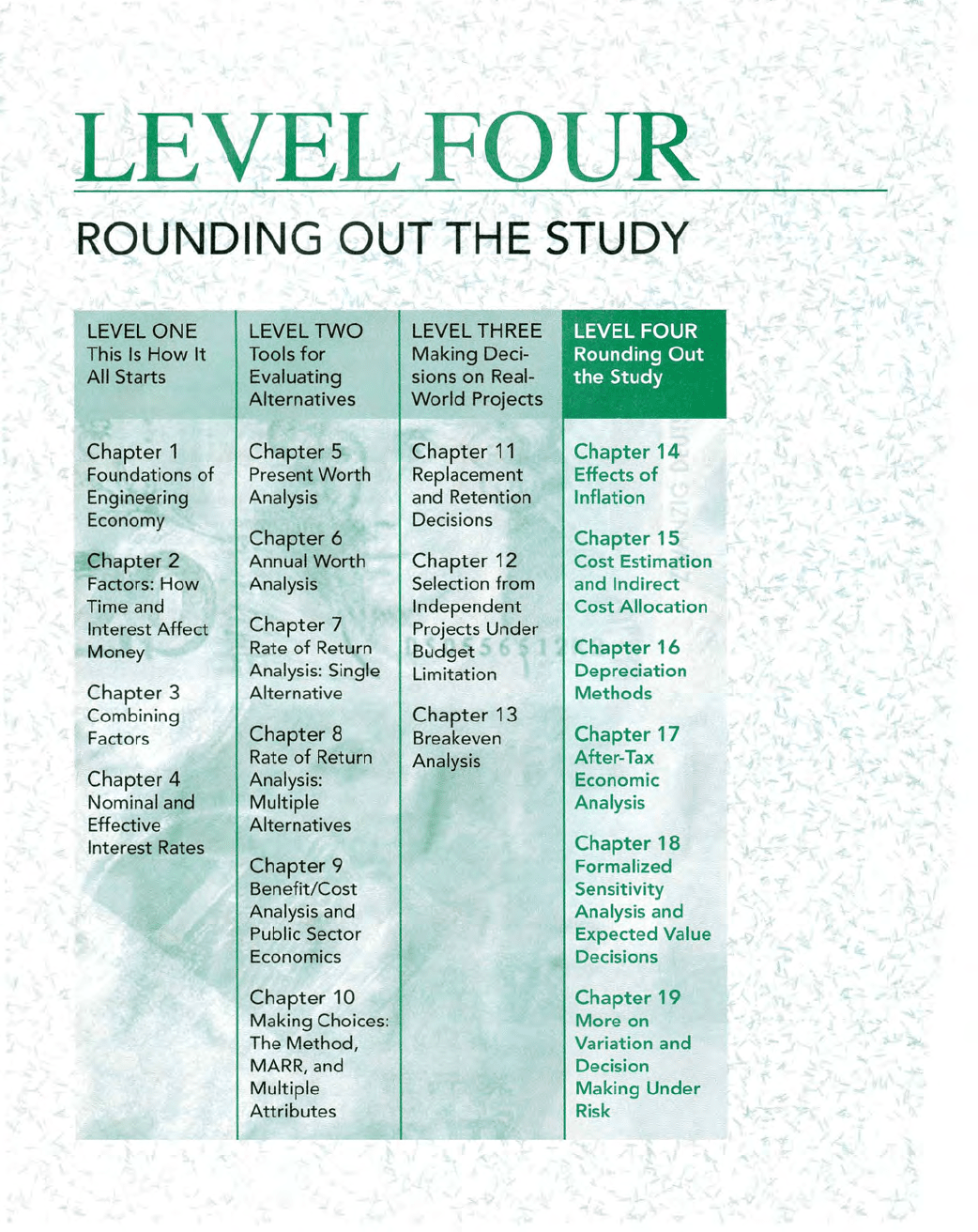
LE
V
EL
FOUR
ROUNDING OUT THE STUDY
LEVEL
ONE
This
Is
How
It
All Starts
Chapter
1
Foundations
of
Engineering
Economy
Chapter
2
Factors:
How
Time and
Interest
Affect
Money
Chapter
3
Combining
Factors
Chapter
4
Nominal and
Effective
Interest Rates
LEVEL
TWO
Tools
for
Evaluating
Alternatives
Chapter
5
Present Worth
Analysis
Chapter
6
Annual Worth
Analysis
Chapter
7
Rate
of
Return
Analysis: Single
Alternative
Chapter
8
Rate
of
Return
Analysis:
Multiple
Alternatives
Chapter
9
Benefit/Cost
Analysis and
Public Sector
Economics
Chapter
10
Making Choices:
The
Method,
MARR, and
Multiple
Attributes
LEVEL
THREE
Making
Deci-
sions
on
Real-
World
Projects
Chapter
11
Replacement
and Retention
Decisions
Chapter
12
Selection
from
Independent
Projects Under
Budget
Limitation
Chapter
13
Breakeven
Analysis
LEVEL
FOUR
Rounding
Out
the
Study
Chapter
14
Effects
of
Inflation
Chapter
15
Cost Estimation
and
Indirect
Cost
Allocation
Chapter
16
Depreciat
ion
Methods
Chapter
17
After-Tax
Economic
Analysis
Chapter
18
Formalized
Sensitivity
Analysis and
Expected Value
Decisions
Chapter
19
More
on
Variation and
Decision
Making
Under
Risk
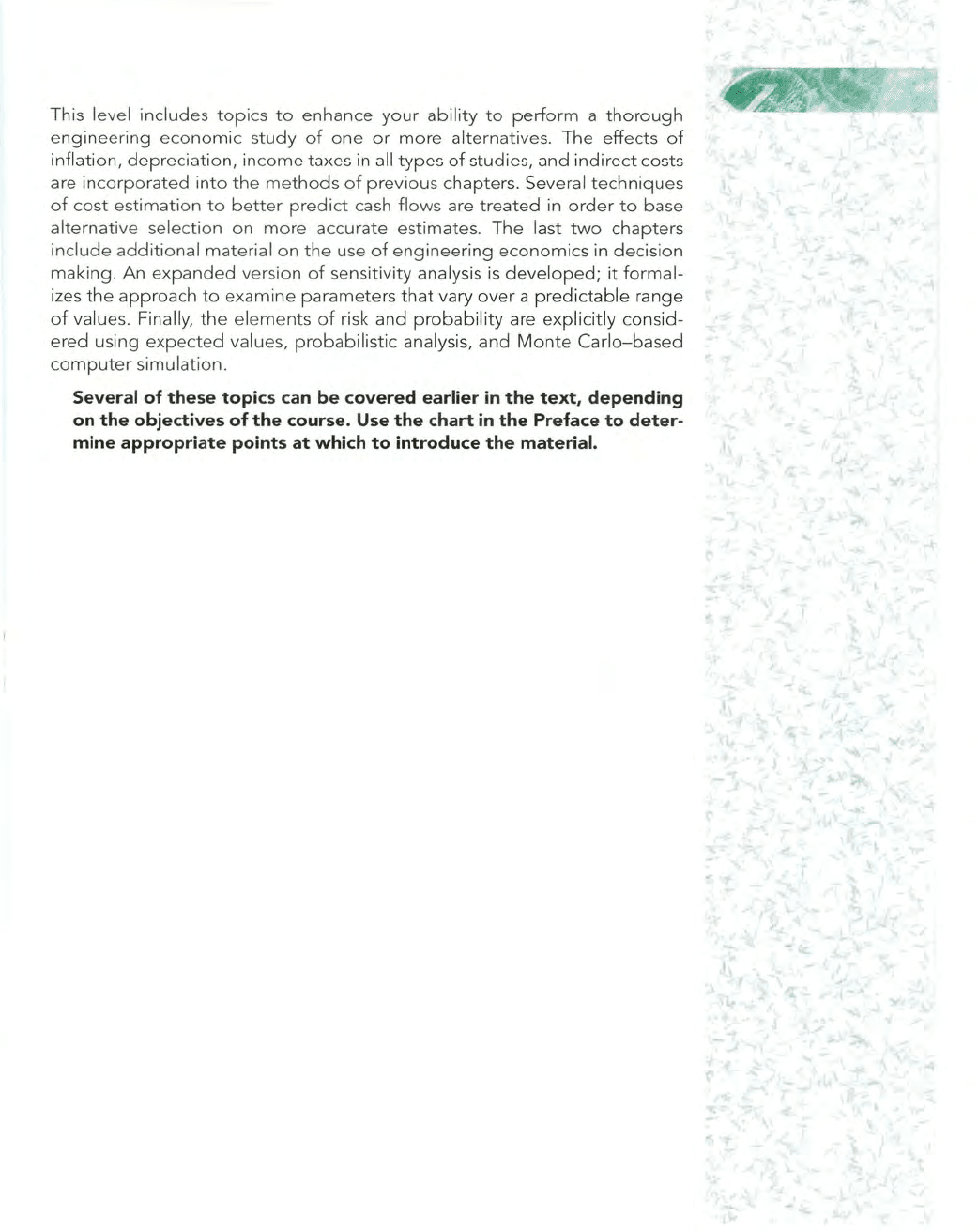
This level i
ncludes
topics
to
enhance
your
ab
ility
to
perform
a
th
oroug
h
e
ngin
eer
ing
econom
ic
study
of
one
or
more alternatives. The effects of
inflation,
depreciation,
in
come
taxes
in
all
types
of
studies, and
indirect
costs
are in
corporated
i
nto
the
methods
of
previous
chapters. Several
tec
hniqu
es
of
cost
estimation
to
better
predict
cash flows are
treated
in ord
er
to
base
alternative
selection on
more
accurate estima
te
s.
The
last
two
chapters
include
additio
nal material
on
the
use
of
engi
neering
economics
in
decision
making.
An
expande
d version
of
sensitiv
ity
analysis
is
developed;
it
formal-
izes
the
a
ppro
ach
to
examine
parameters
that
vary
over
a
predictable
range
of
values. Finally,
the
el
ements
of
risk and
probab
ility are ex
plicitly
consid-
ered
u
si
ng
expected
va
lu
es,
probabilistic
analysis, and
Monte
Carlo-based
comp
ut
er
simulation.
Several
of
these
topics can
be
covered
earlier
in
the
text,
depending
on
the
objectives
of
the
course. Use
the
chart
in
the
Preface
to
deter-
mine
appropriate
points
at
which
to
introduce
the
material.
....
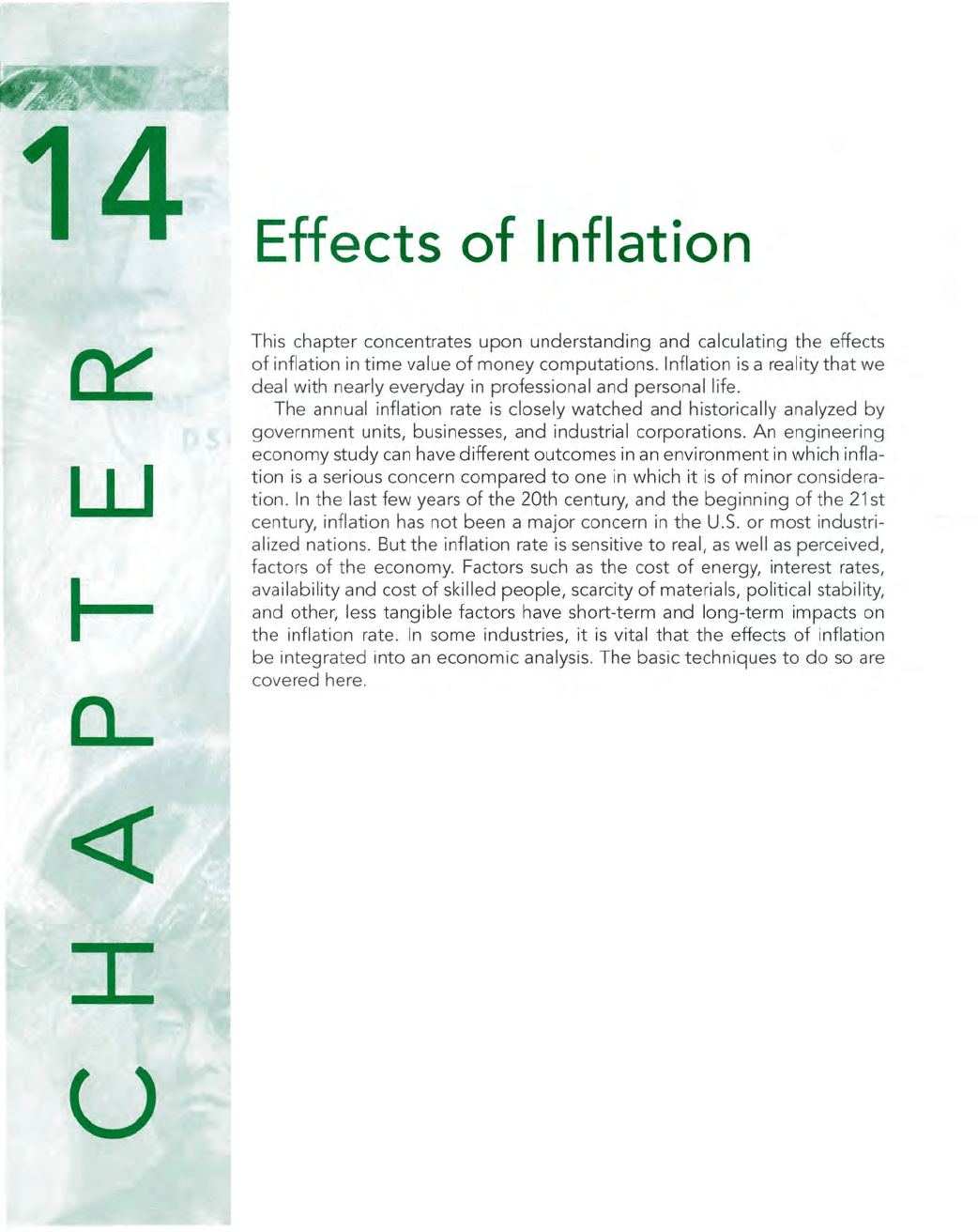
14
UJ
I-
a...
I
u
Effects
of
Inflation
This
chapte
r
co
ncen
tr
ates
upon
understanding
and
ca
lculating
the
effects
of
inf
l
ation
in
time
value
of
money
computa
tions
. Inflation
is
a reality
that
we
deal
with nearly
everyday
in professional
and
personal life.
The
annual
inflation
rate
is
closely
watched
and historically analyzed
by
government
units, businesses,
and
industrial
corporations.
An
engi
neering
eco
nomy
s
tudy
can have
different
outcomes
in
an
environment
in
which infla-
tion
is
a serious
co
ncern
compared
to
one
in which
it
is
of
minor
considera-
tion
.
In
the
last f
ew
years
of
the
20th
century,
and
the
beginning
of
the
21
st
century,
inflation
has
not
been
a
major
concern in
the
U.S.
or
most
i
nd
ustri-
alized nations.
Bu
t
the
inflati
on
rate
is
sensitive
to
real,
as
we
ll
as
perceived,
factors
of
the
economy
. Factors such
as
the
cost
of
energy
,
int
erest rates,
availabi
lit
y
and
cost
of
skilled
people,
sca
rcity
of
materials,
politi
ca
l st
ab
ility,
and o
th
e
r,
less
tangible
factors have short
-t
erm
and
long-term
impacts
on
the
infl
at
ion rate.
In
so
me
industries,
it
is vital
that
th
e effects of inflation
be
integrated
into an
econom
ic analysis.
The
basic
techniques
to
do
so are
covered
here.
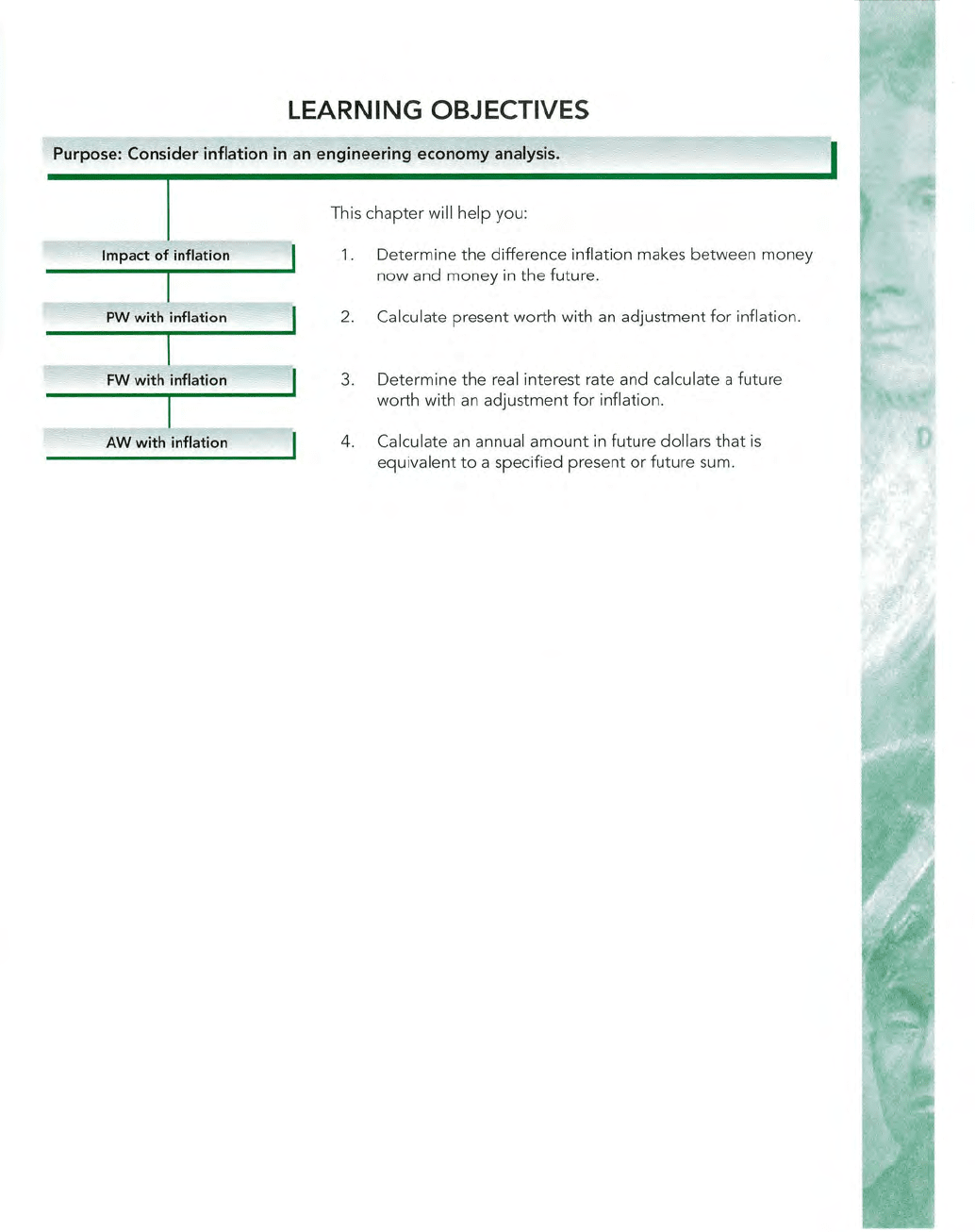
LEARNING OBJECTIVES
Purpose: Consider inflation
in
an
engineering economy analysis.
Impact of inflation
PW with inflation
FW with inflation
AW with inflation
This
chapter
will
help
you:
1.
Determine
the
difference
inflation
makes
between
money
now
and
money
in
the
future.
2.
Calculate
present
worth
with
an
adjustment
for
inflation.
3.
Determine
the
real
interest
rate
and
calculate
a
future
worth
with
an
adjustment
for
inflation.
4.
Calculate
an annual
amount
in
future
dollars
that
is
equivalent
to
a
specified
present
or
future
sum.
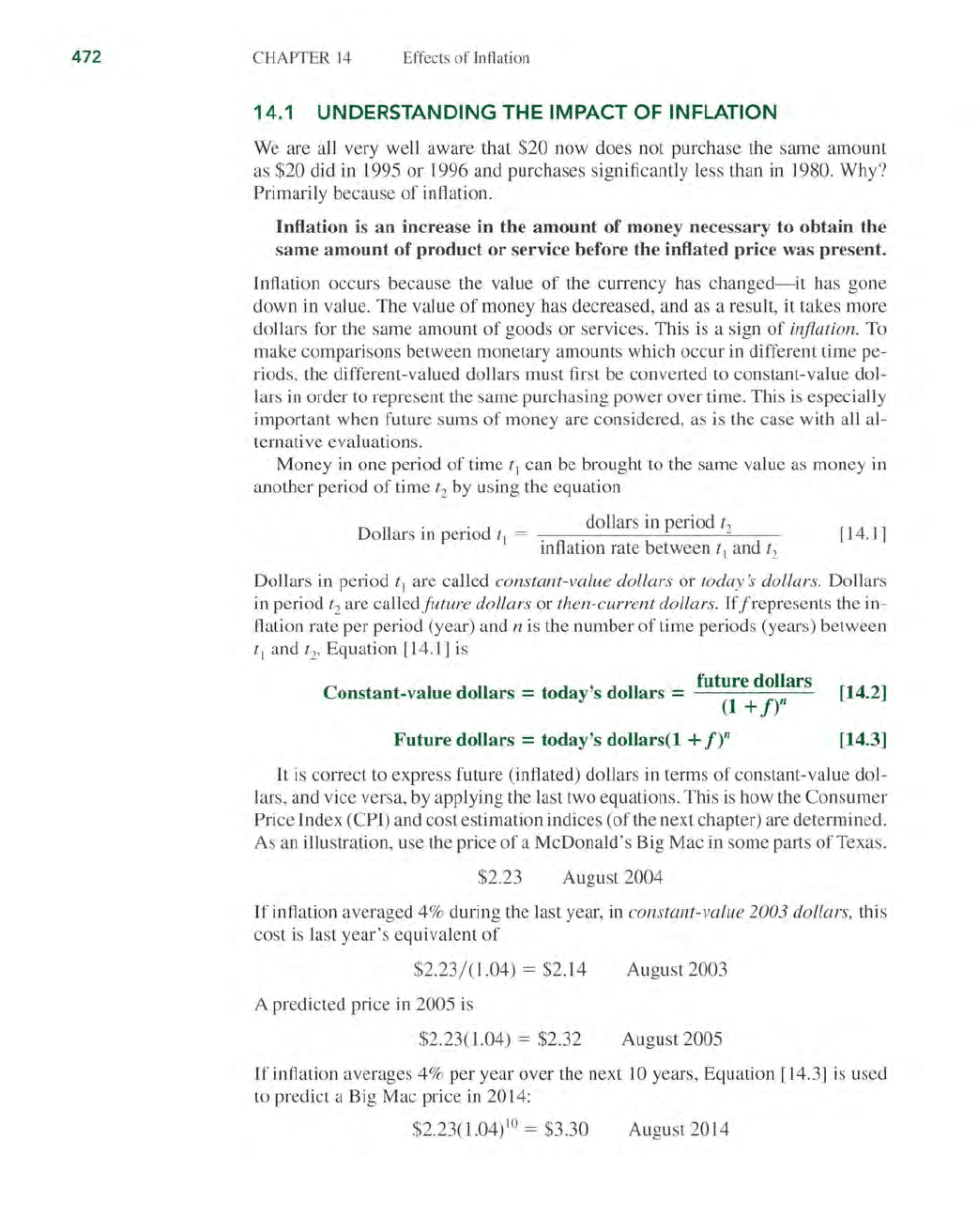
472
CHAPTER
14
Effects
of
Inflation
14.1 UNDERSTANDING THE IMPACT OF INFLATION
We are all very well aware that $20 now does not purchase the same amount
as
$20
did
in
1995
or
1996 and purchases significantly less than in 1980. Why?
Primarily because
of
inflation.
Inflation
is
an
increase in
the
amount
of
money necessary to obtain the
same
amount
of
product
or
service before the inflated price was present.
Inflation occurs because the value
of
the currency has
changed-it
has gone
down
in
value.
The
value
of
money has decreased, and as a result, it takes more
dollars for the same
amount
of
goods
or
services. This is a sign
of
inflation. To
make comparisons between monetary amounts
which
occur
in
different time pe-
riods, the different-valued dollars must first be converted to constant-value dol-
lars
in
order to represent the
same
purchasing
power
over time. This is especially
important when future sums
of
money are considered, as
is
the case with all al-
ternative evaluations.
Money
in
one
period
of
time
tl
can be brought to the same value as money
in
another period
of
time
t2
by using the equation
D
11
. . d dollars
in
period f?
oars
111
peno
fl = -
inflation rate between
fl
and t2
[14.1 ]
Dollars
in
period
tl
are called constant-value dollars
or
today's dollars. Dollars
in
period
t2
are called future dollars
or
then-current dollars.
Iff
represents the i n-
flation rate per period (year) and n is the number
of
time periods (years) between
II
and f
2
,
Equation [14.1] is
future
dollars
Constant-value dollars
=
today's
dollars =
(1
+
f)"
[14.2]
Future
dollars =
today's
dollars(1 +
f)"
[14.3]
It
is
correct to express future (inflated) dollars
in
terms
of
constant-value dol-
lars, and vice versa, by applying the last two equations. This is how the
Consumer
Price Index (CPI) and
cost
estimation indices
(of
the next chapter) are determined.
As an illu
st
ration, use the price
of
a
McDonald'
s Big
Mac
in
some parts
of
Texa
s.
$2.23 August 2004
If
inflation averaged 4% during the last year,
in
constant-value 2003 dollars, this
cost
is
last
year's
equivalent
of
$2.23/(
1.04) = $2.14 August 2003
A predicted price
in
2005 is
$2.23(1.04)
= $2.32
August
2005
If inflation averages 4% per year over the next 10 years, Equation [14.3]
is
used
to predict a
Big
Mac
price
in
2014:
$2.23(1.04)10
= $3.30
August
2014
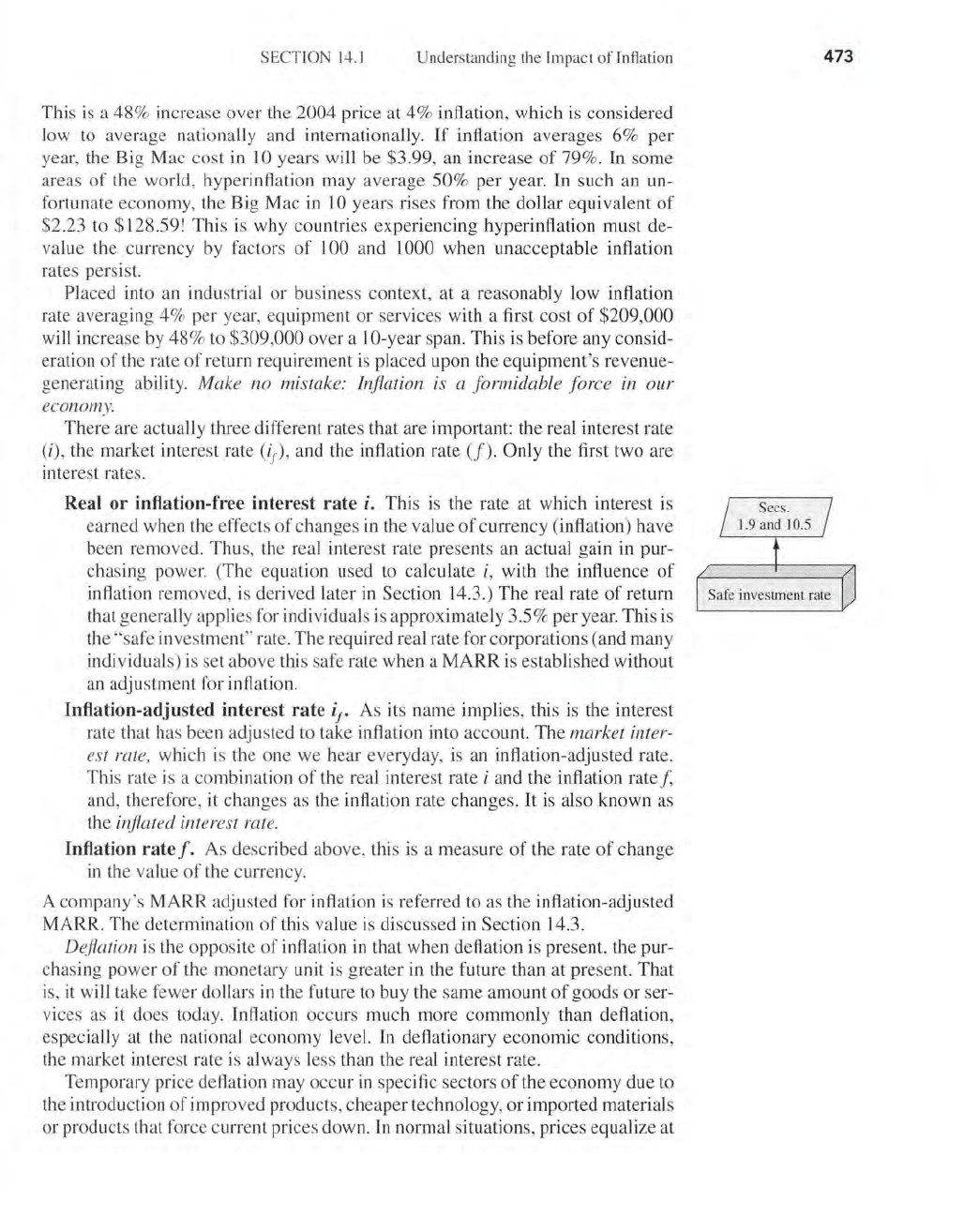
SECTION 1
4.
1
Understanding
the
Impa
ct
of
Inflation
This
is
a 48% increase
over
the 2004 price at 4% inflation, which is considered
low to average nationally and internationally.
If
inflation averages
6%
per
year, the
Big
Mac
cost
in
10 years will be $3.99, an increase
of
79
%.
In
some
areas
of
the world, hyperinflation may average
50
% per year. In such an un-
fortunate economy, the Big Mac
in
LO
years rises from the dollar equivalent
of
$2.23 to $128.59! This is why countries experiencing hyperinflation must de-
value the currency by factors
of
100 and 1000 when unacceptable inflation
rates persist.
Placed into
an
industrial
or
business context, at a reasonably low inflation
rate avera
gi
ng 4% per year, equipment
or
services with a first cost
of
$209,000
will
in
crease by 48% to $309,000 over a lO-year span. This is before any consid-
eration
of
the rate
of
return requirement is placed upon the equipment's revenue-
generating ab
ili
ty. Make no mistake: Inflation is a formidable force in our
econom
y.
There are actually three different rates that are important: the real interest rate
(i), the market interest rate
(if)'
and the inflation rate
(f)
. Only the first two are
interest rate
s.
Real
or
inflation-free interest
rate
i. This is the rate
at
which interest is
ea
rn
ed when the effects
of
changes
in
the value
of
currency (inflation) have
been removed. Thus,
th
e real interest rate presents an actual gain in pur-
chasing power. (The equation used to calculate
i,
with the influence
of
inflation removed, is derived later
in
Section 14.3.) The real rate
of
return
th
at genera
ll
y applies for individuals is approximately 3.5% per year. This is
th
e
"s
afe investment" rate. The required real rate for corporations (and many
individuals) is set above thjs safe rate when a
MARR
is established without
an
adjustment for inflation.
Inflation-adjusted interest
rate
ir
As its name implies, this
is
the interest
rate that has been ad
ju
sted to take inflation into account.
The
market inter-
est rate, w
hi
ch is the one we hear everyday, is an inflation-adjusted rate.
This rate
is
a combination
of
the real interest rate i and the inflation rate
f,
and, therefore, it changes as the inflation rate changes. It
is
also known as
the
in
flated interest rate.
Inflation
ratef.
As described above, thjs is a measure
of
the rate
of
change
in
the va
lu
e
of
the currency.
A company's
MARR
adjusted for inflation is referred to as the inflation-adjusted
MARR. The determination
of
this value is discussed in Section 14.3.
Deflation
is
the opposite
of
inflation
in
that when deflation is present, the pur-
chas
in
g power
of
the monetary unit is great
er
in the future than at presen
t.
That
is
, it w
ill
take fewer dollars
in
the future to buy the sa
me
amount
of
goods
or
ser-
vices as
it
does today. Inflation occurs much more commonly than deflation,
especially at the national economy level. In deflationary economic conditions,
the market interest rate is always less than the real interest rate.
Temporary price deflation may occur
in
spe
cific sectors
of
the economy due to
the introduction
of
improved products, cheaper technology,
or
imported materials
or products that force currenl prices down. In normal situations, prices equalize
at
473
Safe investme
nt:
rate
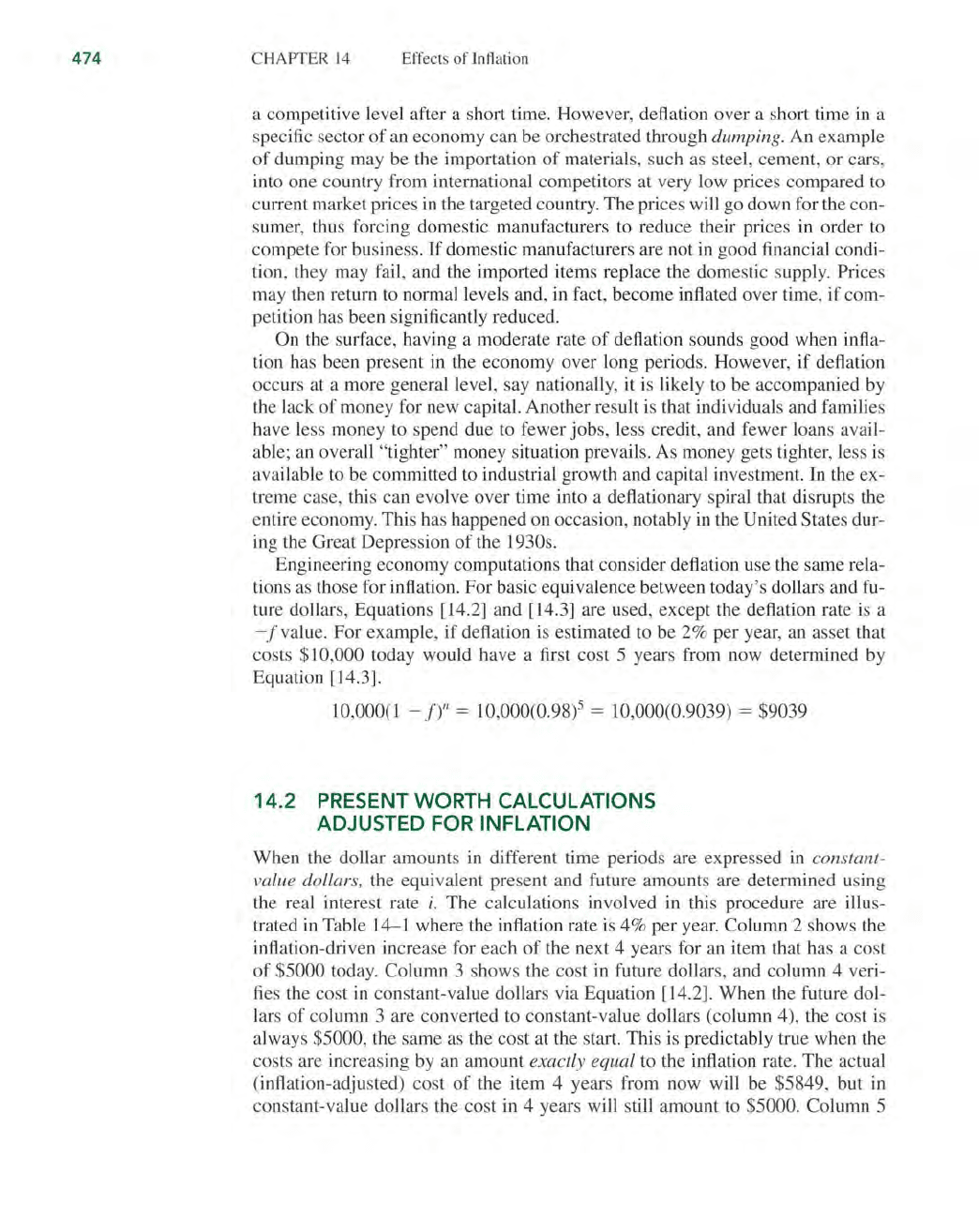
474
CHAPTER
14
Effects
of
Inflation
a competitive level after a short time. However, deflation over a short time in a
specific sector
of
an economy can be orchestrated through dumping. An example
of
dumping may be the importation
of
materials, such as steel, cement, or cars,
into one country from international competitors at very low prices compared to
current market prices in the targeted country. The prices will go down for the con-
sumer, thus forcing domestic manufacturers to reduce their prices in order to
compete for business.
If
domestic manufacturers are not in good financial condi-
tion, they may fail, and the imported items replace the domestic supply. Prices
may then return to normal levels and, in fact, become inflated over time,
if
com-
petition has been significantly reduced.
On the surface, having a moderate rate
of
deflation sounds good when infla-
tion has been present
in
the economy over long periods. However,
if
deflation
occurs at a more general level, say nationally, it is likely to be accompanied by
the lack
of
money for new capital. Another result is that individuals and families
have less money to spend due to fewer jobs, less credit, and fewer loans avail-
able; an overall "tighter" money situation prevails.
As
money gets tighter, less
is
available to be committed to industrial growth and capital investment.
In
the ex-
treme case, this can evolve over time into a deflationary spiral that disrupts the
entire economy. This has happened on occasion, notably in the United States dur-
ing the Great Depression
of
the 1930s.
Engineering economy computations that consider deflation use the same rela-
tions as those for inflation. For basic equivalence between today's dollars and fu-
ture dollars, Equations [14.2] and [14.3] are used, except the deflation rate is a
-f
value. For example,
if
deflation is estimated to be 2% per year, an asset that
costs
$10,000 today would have a first cost 5 years from now determined by
Equation [14.3].
10,000(1 -
f)"
= 10,000(0.98)5 = 10,000(0.9039) = $9039
14
.2 PRESENT WORTH CALCULATIONS
ADJUSTED FOR INFLATION
When the dollar amounts
in
different time periods are expressed in constant-
value dollars,
the equivalent present and future amounts are determined using
the real interest rate
i.
The calculations involved in this procedure are illus-
trated
in
Table 14-1 where the inflation rate is 4% per year. Column 2 shows the
inflation-driven increase for each
of
the next 4 years for an item that has a cost
of
$5000 today. Column 3 shows the cost in future dollars, and column 4 veri-
fies the cost in constant-value dollars via Equation [14.2]. When the future dol-
lars
of
column 3 are converted to constant-value dollars (column 4), the cost is
always
$5000, the same as the cost at the start. This is predictably true when the
costs are increasing by an amount
exactly equal to the inflation rate. The actual
(inflation-adjusted) cost
of
the item 4 years from now will be $5849, but in
constant-value dollars the cost in 4 years will still amount to
$5000. Column 5
